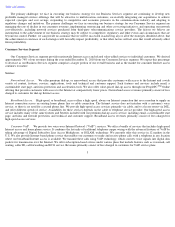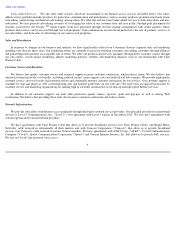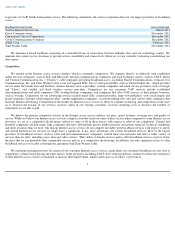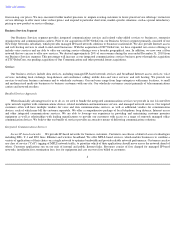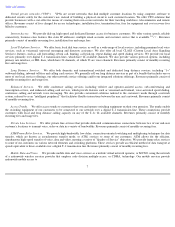Earthlink 2010 Annual Report Download - page 17
Download and view the complete annual report
Please find page 17 of the 2010 Earthlink annual report below. You can navigate through the pages in the report by either clicking on the pages listed below, or by using the keyword search tool below to find specific information within the annual report.
Table of Contents
Collectively, these requirements recognize that local telephone service competition is dependent upon cost-based and non-
discriminatory
interconnection with, and use of, some elements of incumbent carrier networks and facilities under specified circumstances. Failure to achieve
and maintain such arrangements could have a material adverse effect on our ability to provide competitive local telephone services.
Over the past decade, decisions of federal courts and the FCC have narrowed significantly the scope of the facilities that incumbent
telephone companies must make available UNEs to competitive carriers such as us at rates based on the Total Element Long Run Incremental
Cost, or TELRIC, standard. Incumbent carriers must offer access to their copper loops and subloops, but must offer access to certain higher-
capacity DS1 and DS3 transmission facilities only in wire center serving areas with relatively few business lines and colocated competitive
carriers, as defined by detailed FCC regulations. In general, incumbent companies are not required to offer UNEs at TELRIC-
based rates for
fiber loops, DS1 and DS3 transmission facilities in relatively large wire centers or wire centers deemed to already be "competitive" based on
FCC standards, optical speed transmission facilities or dark fiber. Further, incumbent companies no longer are required to provide local
switching as a UNE, which means that we can no longer rely on the Unbundled Network Element-Platform, or UNE-
P, to provide local services
to customers at TELRIC-
based rates. In some circumstances, AT&T, Verizon and other incumbent carriers are making available some of these
facilities and services, either as lightly regulated special access services or under unregulated "commercial agreements," at significantly higher
rates.
Interconnection Agreements.
Under the Communications Act, incumbent carriers are required to negotiate in good faith with competitive
carriers such as us interconnection, colocation, reciprocal compensation for local traffic and access to UNEs. If the negotiating carriers cannot
reach agreement within a prescribed time, either carrier may request binding arbitration of the disputed issues by a state regulatory commission.
In addition, carriers are permitted to "adopt" in their entirety agreements reached between the incumbent carrier and another carrier during the
initial term of that agreement.
An interconnection agreement typically has a term of three years, although the parties may mutually agree to extend or amend such
agreements. We operate under interconnection agreements with AT&T, Verizon, Qwest, Frontier Communications, CenturyLink, Fairpoint
Communications and Windstream. Our retail operating companies each maintain interconnection agreements with the incumbent in each state
and for each service territory within which we purchase UNEs. We expect, but cannot assure, that each new interconnection agreement to which
we are or will be a party will provide us with the ability to provide service in each respective state on a reasonable commercial basis. In addition,
new agreements could result in less favorable rates, terms and conditions than our prior agreements. If we cannot negotiate new interconnection
agreements or renew our existing interconnection agreements in each state on acceptable terms, we may invoke our ability to seek binding
arbitration before state regulatory agencies. The arbitration process, which is conducted on a state-by-state basis, can be costly and time-
consuming, and the results of arbitration may be unfavorable to us. If we are not able to renegotiate or enter into interconnection agreements on
acceptable terms, or if we are subject to unfavorable arbitration decisions, our cost of doing business could increase and our ability to compete
could be impeded. Moreover, our interconnection agreements and traffic exchange with companies other than incumbent local exchange carriers
(such as wireless and VoIP providers and other competitive carriers) are not subject to the statutory arbitration mechanism, making it potentially
more difficult to reach any agreement on terms that we view as acceptable.
The mergers of BellSouth, SBC and AT&T and of MCI and Verizon have significantly affected the availability of acceptable
interconnection agreements that competitive carriers such as us can adopt without incurring the expense of lengthy negotiation and arbitration
with an incumbent carrier in each state. Before their respective mergers, AT&T and MCI dedicated significant internal and external resources to
negotiate and arbitrate interconnection agreements that many competitive carriers adopted or used as model agreements. These resources and the
resulting model agreements are no longer available as
13


